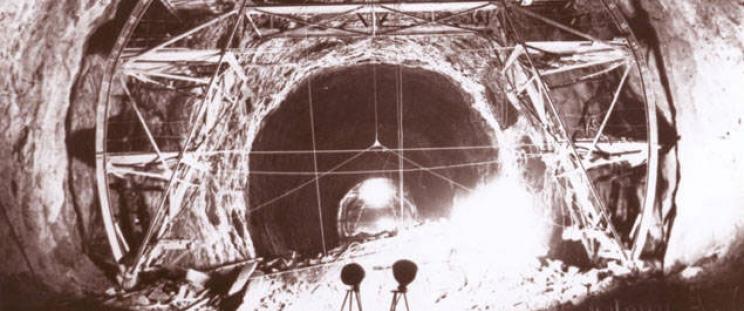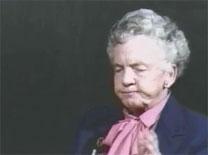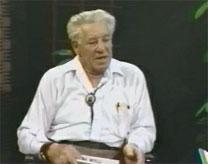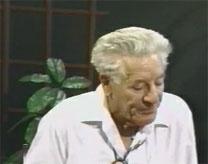Collection Paragraphs


When men were able to find work in the first phase of the dam construction it was occasionally on an auxiliary project such as building rail lines to the dam. Most men, however, found themselves working on the construction of the diversion tunnels. Before the dam could be built, the Colorado River needed to be temporarily diverted from its course. Four tunnels were planned, two on each side of the river. The most difficult part of the entire project, the construction of the diversion tunnels began May 12, 1931 and was scheduled to be completed before October 1, 1933. As Six Companies would be fined for every day the diversion tunnels went over schedule, the excavation of the tunnels proceeded at a furious pace.
When completed, the diameter of each tunnel would measure 50 feet wide, 3/4 of a mile in length. The mechanics of drilling into the solid rock walls of Black Canyon did not daunt dam foreman, Frank Crowe. Knowing that it would take countless men to make even an inch of headway into the walls, Frank Crowe came up with an idea that would allow over twenty men to drill at once. This invention, called a jumbo, consisted of rows of platforms built atop a truck. Men would stand on the platforms to drill and tamp blasts into the rock.

Six Companies knew that it would be a major task to feed the number of men required to work on the dam. At the height of construction, over 5000 men were employed on the project. To face the daunting challenge of feeding the workers, Six Companies hired Anderson Brothers out of California.
During the Depression, having three square meals a day was a luxury that most people couldn't afford. As a result, one of the most anticipated events while working on the dam was meal time. A man could eat as much as he wanted, the Anderson Mess Hall workers kept a constant supply of food running to the tables.
"For Thanksgiving they had a whole carload of turkeys. You can't imagine the intensity of all the stuff that they had, cooking in there to feed this many people." Leroy Burt
Holidays were an added treat because families were invited to the mess hall for a cheap dinner:
"You'd go up there [Anderson Mess Hall], and Thanksgiving cost a whole seventy-five cents. The wife and I, seventy-five cents apiece; for the girl, it was free. So that cost as $1.50. You'd have turkey, roast beef, anything under the sun as long as you wanted." Marion Allen
Working on the diversion tunnels presented unique dangers. Not only did men have to be constantly wary of blasting and falling rocks, they also had to deal with truck fumes. Diesel trucks were used to haul debris out of the gradually forming tunnels. Although fans and pipes were used to circulate the air, exhaust became trapped in the tunnels. Numerous men were diagnosed with a mysterious pneumonia. Rumors spread saying that the men didn’t really have pneumonia but were sick from inhaling the gas fumes. Even though this was never officially proven, dam workers were certain that the fumes were responsible for sickness among the men.

The workers did not allow threats of danger or sickness to keep them from doing their jobs. Once lights were installed in the diversion tunnels, work was able to progress around the clock without interruption. The different work crews competed with each other to see who could drill the most from day to day. Recognizing that the friendly competition was having positive effects, supervisors encouraged the rivalry.
Once the tunnels had been drilled, they needed to be resurfaced with concrete. Elaborate forms and concrete guns were used to pour cement throughout the tunnels. By November of 1932 the tunnels were finished, almost a full year ahead of schedule. It was time to divert the river.
A cofferdam needed to be constructed to force the river into the tunnels. Over 100 hundred trucks dropped tons of dirt, rock, and debris into the river at a rate of one truckload every 15 seconds. The loud and dusty process continued throughout the night. The cofferdam was slowly built until finally it broke the surface of the water. The river surged against the cofferdam, trying to find a way through. As the water rose, activity on the site stilled as spectators waited with bated breath. Early on the morning of November 14, 1932 the Colorado was forced into the mammoth, concrete-lined tunnels. The river had been diverted.
The number of men working on the project was huge, making it impossible to know everyone, even if on the same shift. However, one member of the crew was known by all: Nig, the Boulder Dam Mascot.
Although his origins were unknown, the men liked to say that Nig, a dog with black fur and a white blaze on his chest, was born under the floorboards of one of the dormitories. Next to Frank Crowe, Nig was probably one of the most respected personalities of the dam. Every morning he would ride to the dam site with the men. On the way to work, Nig carried his own lunch sack, provided by Anderson Mess Hall. He would put his lunch where the men kept theirs and wouldn't eat until they took their meal break. During the work day, Nig would walk around the construction, as if he were supervising the men at work. His constant presence buoyed the men's spirits. The dog was so well loved, that insulting him or causing him harm would result in a brawl.
Like so many other "construction stiffs," Nig died on the job. One day, while sleeping under a truck, Nig was crushed under the tires when the truck moved. The workers honored the mascot by burying him at the dam and placing a memorial in his name. Many years later, a visitor to the dam said that the name "Nig" was racist, and it was decided that the memorial should be changed to read "Boulder Dam Mascot."
